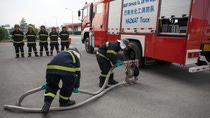Professional firefighting capability based on emergency response system
At the main production sites of BASF Greater China, there is such a scene: uniformly dressed firefighters full of energy carrying out training regardless of the weather; behind them eye-catching red gates and neatly arranged high-professional fire engines and emergency equipment. In case of a fire alarm, the brigade will rush to the scene with their equipment.
As the world’s leading chemical company, BASF applies global uniform emergency response standards. As an important part of the emergency response management system, the BASF Fire Department performs tasks that include the design of a fire protection plan for the plants, development of firefighting and prevention plans. They also undertake emergency response plans, fire drills, training of staff on emergency knowledge and skills and emergency accident management, among others.
For Li Zuobin, Emergency Response Supervisor at BASF Chemical Co., Ltd., the large fire that broke out at the Shanghai Chemical Industrial Park in September 2011 is still impressive.
The quiet night was broken by a sound of an explosion and hurried alarm. One production facility of a company in the park exploded and was engulfed by a large fire. On receiving his superior’s order, Li, then a firefighting shift foreman on active military duty, assembled the firefighters and led them to the scene with two fire engines from the BASF fire brigade. “At that time, the situation was very critical. The flames lit up the night sky. Even when we tried to approach the central point from the upwind direction we still felt the scorching heat. The accompanying squeaks of the leaking materials indicated that there was likely to be a second explosion, which may cause harm to the personnel on the spot,” he recalled.
On receiving his orders from the accident command center, Li led the team to set up mobile cannons in favorable directions to cool and protect the major parts of the facility and the storage tanks. With years of experience he deemed that the situation was very dangerous and risky. He immediately reported to the command center. To avoid any accident and to control the fire, they needed to reduce the number of frontline firefighters and use more fixed and vehicle-mounted firefighting equipment. His suggestion was quickly adopted by the center. Through the adjustment in water cannons and gun positions and tactics, the entire fire rescue was able to continue under a safe situation. Li and his colleges fought the blaze until 4 a.m. when the fire was extinguished.
In joining the armed police fire brigade in 1997 Li has accumulated nearly 20 years of firefighting experience, developing a strong psychological quality. Even in critical moments he remains calm and makes clear and professional judgments on the scene. He was rewarded for his excellent performance, while the rescue this time was just one of his successful cases.
Li attributes the effective control of this chemical fire to four aspects. First, the improvement of firefighting infrastructure on site. There were dozens of firefighting vehicles on site that required a large use of water. Thanks to the reasonable design and sufficient allocation of firefighting equipment, the water supply was never interrupted during the rescue. Secondly, the facilities were designed with measures to ensure process safety. For example, in case of material leakage, the upstream valve could be closed and the pipes could be cut off to effectively prevent the spread of the accident. Thirdly, advanced firefighting equipment, such as automatic-swinging cannons, mobile cannons, atomizers, special vehicles and special-vehicle equipment, significantly improved the efficiency of firefighting. The last point that cannot be ignored is the daily training of firefighters. Without solid basic theories, physical fitness and regular training, any fault at the scene might lead to failure of the rescue.

“Personal safety is the top priority for both firefighters and people to be rescued.”
Li Zuobin, Emergency Response Supervisor at BASF Chemical Co., Ltd.
As a frontline firefighter, Li once advocated heroism. “Through the training provided by firefighting experts from BASF’s German headquarters and my daily practice I have gradually changed my mind,” he said. “Personal safety is the top priority for both firefighters and people to be rescued.”
For Li, this was his biggest gain from the training. For example, since it was not clear if the rainwater in the plant contained hazardous materials, experts required firefighters to wear personal protective equipment before dealing with it, which will significantly avoid possible harm and ensure their personal safety. Inspired by this, Li abandoned his previous practice in fire rescue. Now he assesses the fire situation and carefully weighs the consequences of each disaster relief action before taking action.
In addition to the rise of relevant awareness, Li has strived to improve his professional competence. He has studied firefighting tools in depth, not only knowing their functions but also working principles. For example, with water guns he knows how they are constructed and spray, thus he is able to use them precisely. Moreover, he has also gotten to know more about material in his duty areas, including the major materials, toxic materials, flammable and explosive materials. He is also able to deal with them. “If one works without thinking he will never make any progress.”
In 2013, Li retired from the military and joined BASF Chemical Co., Ltd. for which he had worked, becoming a formal BASF emergency response specialist responsible for fire prevention and emergency response coordination. On March 28, 2017, BASF Chemical Co., Ltd. completed the transformation and handover of its fire brigade, becoming Shanghai’s first corporate-established fire brigade of an international company. The new full-time fire brigade is composed of BASF employees and contractors, and Li has become a fire brigade on-site commander once again.
Li maintains his practice of continuous learning. His latest task is to participate in the construction of BASF’s standard emergency response force. This fire brigade will be trained according to BASF’s global uniform standard, and explore the professional development of corporate fire brigades. This initiative will also greatly enhance the stability of the team and help to accumulate and improve its technical and tactical capacities.
The corporate fire brigade has also shown personnel diversity: it includes not only those who were once engaged in professional firefighting work like Li, but also operation and technical personnel of production plants who are familiar with the chemical facilities and have good chemical knowledge, operational skills and emergency operation capacity. “Our fire brigade needs to have the expertise to deal with chemical hazards so the training after the transformation will be more professional and comprehensive,” said Yue Haibing, Emergency Response Manager, Responsible Care and Service, BASF Greater China. “It will focus on safe handling of hazardous chemicals in emergency situations.”
In addition to the existing equipment, the transformed fire brigade will have more advanced professional firefighting equipment, including the forthcoming turbo-jet fire engine, the first ever at the Shanghai Chemical Industrial Park. The turbo engine is used to spray whirled water and handles hazardous gas and vapor clouds by eddying water from long distances, thereby increasing efficiency and minimizing personnel risk in emergency response. “In future, this fire brigade will take on more work,” said Yue. “The firefighters will likely provide professional emergency and firefighting training and support for other BASF plants in China.”

“BASF will continue to implement its corporate social responsibility, actively practice the concept of EHS and further promote the implementation of Responsible Care in the China chemical industry, thus promoting the common progress of the industry.”
Charlie Zhang, Director, Responsible Care, BASF Greater China
In the emergency response, the fire department is most obvious – but a comprehensive emergency response system is more than the establishment of a fire brigade and professional training.
“BASF never compromises on safety. This principle is anchored in our strategy,” said Charlie Zhang, Director, Responsible Care, BASF Greater China. “Emergency response means being prepared for possible incidents in our company at any time and at any place. This applies to production at our sites as well as our transport chains.”
Under the Responsible Care Management System (RCMS)1, BASF applies a global uniform safety standard and adopts a structured procedure to assess all its sites worldwide. BASF Greater China strictly enforces relevant standards. The global binding directives and requirements regarding process safety, for example, regulate the safe design, construction and operation of the plants and define the use of specific methods and procedures for the individual elements of process safety. The experts identify and assess possible risks during the design process of new plants in periodic reviews during the operation of existing plants and when plant or recipes changes are performed.
Based on the concept of mutual aid, BASF has established an off-site emergency network in China: sites provide consultancy, rescue and support to other sites in case of an accident during transportation within the region. All accidents are first reported via BASF’s Emergency Call Center, which provides 24-hour service to our sites, customers and the public.
In addition, BASF has been working with China’s State Administration of Work Safety (SAWS) and China Petroleum and Chemical Industry Federation (CPCIF) to share best practices on emergency response, and support local authorities in the development of emergency and rescue skills on hazardous chemicals.
“The combination of a comprehensive prevention system with professional firefighting competence is the best way of ensuring safe production,” said Zhang. “With a wealth of industry knowledge and experience, BASF will continue to implement its corporate social responsibility, actively practice the concept of environment, health and safety (EHS) and further promote the implementation of Responsible Care in the China chemical industry, thus promoting the common progress of the industry.”
Responsible Care is a voluntary initiative of the chemical industry to continuously improve its performance in the areas of environmental protection, health and safety. BASF has committed to the principles of Responsible Care since 1992. Environmental protection, health and safety, as well as security, communication, and energy efficiency, are embedded in its global Responsible Care® policy, which is applied to operations via the Responsible Care Management System (RCMS).
